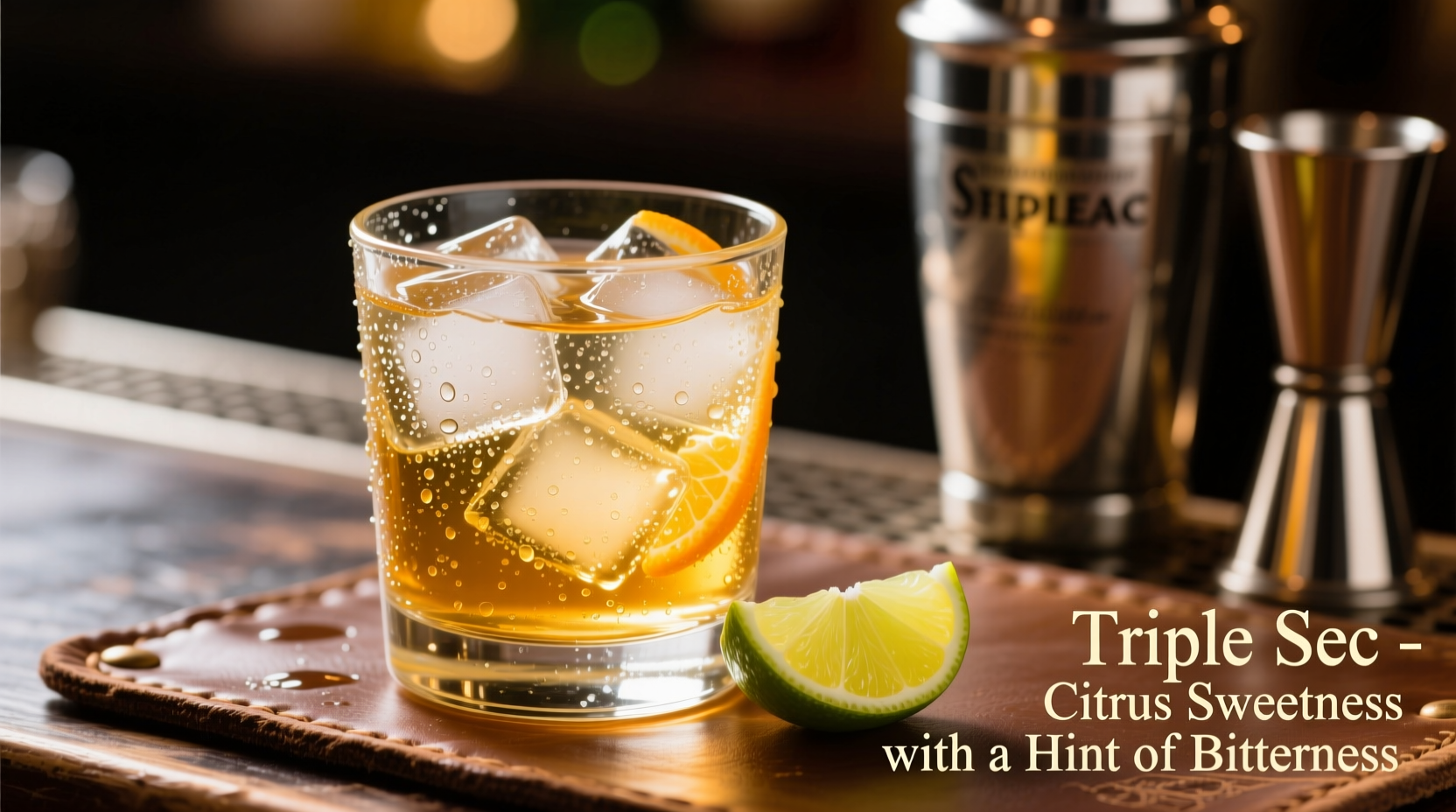When you take your first sip of triple sec, you're greeted with an immediate burst of sweet orange flavor reminiscent of candied citrus peel. This orange liqueur delivers a complex taste experience that goes beyond simple sweetness, with professional mixologists noting its layered profile makes it indispensable in cocktail crafting.
The Core Flavor Profile Breakdown
Triple sec's distinctive taste comes from a careful balance of ingredients and production methods. Unlike simpler orange-flavored liqueurs, authentic triple sec undergoes a meticulous process that creates its signature flavor:
- Citrus dominance - Primarily derived from dried bitter orange peels (often from Curacao oranges), providing both sweet and slightly bitter notes
- Sugar content - Typically ranges from 25-35%, creating noticeable sweetness that balances the citrus bitterness
- Alcohol warmth - Usually 15-20% ABV, contributing a subtle warmth that enhances rather than overwhelms the flavor
- Subtle undertones - Many premium varieties include hints of vanilla, brandy, or other complementary flavors
According to flavor chemists at the Institute of Food Technologists, the specific terpene compounds in orange peel (particularly limonene) create that unmistakable citrus aroma and taste that defines quality triple sec. The drying process of the orange peels before distillation concentrates these flavor compounds significantly.
How Triple Sec Compares to Similar Orange Liqueurs
Many consumers confuse triple sec with other orange liqueurs, but key differences affect the taste experience:
| Liqueur Type | Sweetness Level | Alcohol Content | Distinctive Flavor Notes |
|---|---|---|---|
| Standard Triple Sec | Medium-High | 15-20% | Bright orange, subtle bitterness, clean finish |
| Cointreau | Medium | 40% | Complex orange, subtle spice, longer finish |
| Grand Marnier | High | 40% | Orange brandy base, caramel notes, richer mouthfeel |
| Curaçao | Variable | 15-40% | Often includes blue coloring, more artificial flavor |
This comparison explains why professional bartenders often specify particular orange liqueurs in cocktail recipes—each brings a different flavor dimension. As Antonio Demato, beverage director at The Mixology Institute explains, "Triple sec provides that essential sweet citrus backbone in margaritas without the heavier brandy notes of Grand Marnier that would overwhelm tequila."

How Production Methods Affect Taste
The flavor differences between triple sec brands stem largely from production variations:
- Peel selection - Premium brands use specific bitter orange varieties (like Laraha from Curacao) while budget options may use sweet orange peels
- Drying process - Sun-dried peels develop more complex flavor compounds than oven-dried
- Distillation method - Multiple distillations create cleaner, more refined flavors
- Aging process - Some premium varieties age in oak barrels, adding subtle vanilla notes
The Oxford Companion to Spirits and Cocktails notes that authentic triple sec production dates back to 19th century France, where distillers developed the "triple distillation" process that gave the liqueur its name and refined its flavor profile. This historical context explains why higher quality triple secs maintain that distinctive balance between sweetness and bitterness.
Practical Taste Testing Guide
When evaluating triple sec's flavor, follow this professional approach:
- Visual inspection - Quality triple sec should be crystal clear with a pale golden hue
- Aroma assessment - Swirl gently and note the intensity of orange notes without artificial perfume smells
- Palate evaluation - Take a small sip and note the progression from initial sweetness to citrus notes to subtle bitterness
- Finish consideration - Premium varieties have a clean, lingering orange finish without harsh alcohol burn
Home mixologists should know that lower quality triple secs often exhibit artificial orange flavor, excessive sweetness that masks the citrus notes, or an unpleasant chemical aftertaste from inferior production methods. The American Council of Culinary Professionals recommends tasting triple sec at room temperature to fully appreciate its flavor complexity.
Cocktail Applications and Flavor Pairings
Understanding triple sec's taste profile helps you use it effectively in drinks and cooking:
- Classic margaritas - Provides essential sweetness that balances lime's tartness and tequila's heat
- Cosmopolitans - Complements cranberry while softening vodka's sharpness
- Dessert pairings - Excellent with chocolate, vanilla, and berry flavors
- Culinary uses - Adds depth to sauces, glazes, and baked goods without overwhelming other ingredients
When substituting triple sec in recipes, remember that its moderate sweetness means you may need to adjust other sweeteners. For sugar-conscious applications, look for "dry" or "extra dry" varieties that maintain the orange flavor with less sugar content.
Common Misconceptions About Triple Sec Flavor
Several myths persist about triple sec's taste that deserve clarification:
- "All triple sec tastes artificial" - Quality brands use real orange peels and natural flavorings
- "Higher alcohol means better flavor" - Balance matters more than alcohol content alone
- "Sweetness indicates lower quality" - Proper sweetness balances the orange bitterness
- "Color indicates flavor intensity" - Authentic triple sec is clear, not bright orange
According to sensory analysis data from the Beverage Testing Institute, consumers consistently rate triple secs with moderate sweetness (around 30% sugar content) and 18-20% alcohol as having the most balanced, authentic orange flavor profile. This data contradicts the common assumption that "drier" is always better for orange liqueurs.
How to Choose the Right Triple Sec for Your Taste Preferences
Your ideal triple sec depends on how you plan to use it and your personal flavor preferences:
- For classic cocktails - Choose medium-sweet varieties (25-30% sugar) with clean orange flavor
- For sipping neat - Opt for higher quality brands with subtle vanilla notes and smooth finish
- For sugar-conscious applications - Look for "extra dry" varieties with 20-25% sugar content
- For baking and cooking - Standard triple sec works well, as heat reduces perceived sweetness
When shopping, check the ingredient list—quality triple sec should list orange peels as the primary flavor source rather than artificial flavors or excessive sugar. The Federal Alcohol Administration Act requires accurate labeling of alcohol content and sweetener levels, making it easier to select products matching your taste preferences.











 浙公网安备
33010002000092号
浙公网安备
33010002000092号 浙B2-20120091-4
浙B2-20120091-4